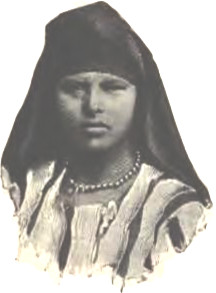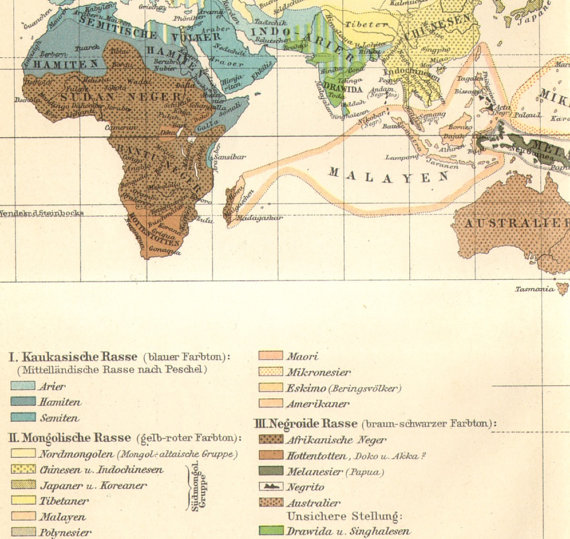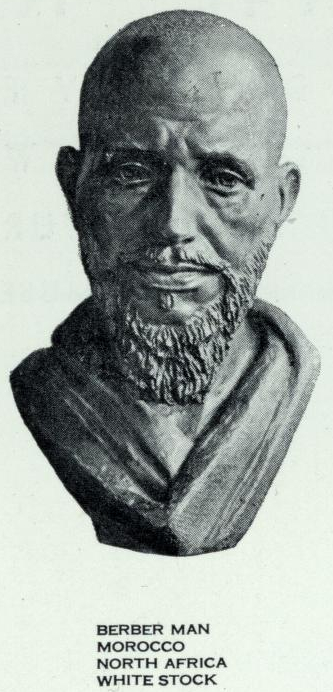
ハム族仮説
Hamites, amitic hypothesis

Egyptian woman with ovoid facial profile, from Giuseppe Sergi's The Mediterranean Race (1901).
☆ハム人とは、植民地主義や奴隷制を
支持するヨーロッパ人によって開発された、人類を異なる人種に分けるという、今では時代遅れのモデルの文脈で、かつて北アフリカやアフリカの角の一部の民
族に使われていた呼称である。この言葉はもともと創世記から借用したもので、ノアの息子ハムの子孫に対して使われている。この呼称は、アフロアジ
ア語族のベルベル語、クシ語、エジプト語の分派に適用され、セム語分派と合わせて以前は「ハム=セム語」と呼ばれていた。しかし、3つのハム語派が、他
のアフロアジア語族の言語から切り離された、独自の(単系統的な)系統学的単位を形成していることが示されていないため、言語学者はもはやこの意味でこの
用語を使用していない。現在では、これらの支流はそれぞれ、より大きなアフロアジア語族の独立したサブグループとみなされている。
19世紀以降、学者たちは一般的にハミタイ人種をコーカサス人種のサブグループとして分類し、アーリア人種やセム人、つまり古代エジプト人を含む北アフリ
カやアフリカの角に住む非セム系住民をグループ化した。ハミティック説によれば、この「ハミティック民族」はサハラ以南のアフリカに住む「ネグロイド」よ
りも優れていた、あるいは進んでいたとされる。最も極端な形では、C.G.セリグマンの著作において、この説はアフリカの歴史における事実上すべての重要
な業績は「ハム人」によるものであると主張した。
1960年代以降、ハム人仮説は他の「人種科学」の理論とともに、科学において完全に信用されなくなった
| Hamites
is the name formerly used for some Northern and Horn of Africa peoples
in the context of a now-outdated model of dividing humanity into
different races which was developed originally by Europeans in support
of colonialism and slavery.[1][2][3][4] The term was originally
borrowed from the Book of Genesis, where it is used for the descendants
of Ham, son of Noah. The term was originally used in contrast to the other two proposed divisions of mankind based on the story of Noah: Semites and Japhetites. The appellation Hamitic was applied to the Berber, Cushitic, and Egyptian branches of the Afroasiatic language family, which, together with the Semitic branch, was thus formerly labelled "Hamito-Semitic".[5] However, since the three Hamitic branches have not been shown to form an exclusive (monophyletic) phylogenetic unit of their own, separate from other Afroasiatic languages, linguists no longer use the term in this sense. Each of these branches is instead now regarded as an independent subgroup of the larger Afroasiatic family.[6] Beginning in the 19th century, scholars generally classified the Hamitic race as a subgroup of the Caucasian race, alongside the Aryan race and the Semitic[7][8] – thus grouping the non-Semitic populations native to North Africa and the Horn of Africa, including the Ancient Egyptians.[4] According to the Hamitic theory, this "Hamitic race" was superior to or more advanced than the "Negroid" populations of Sub-Saharan Africa. In its most extreme form, in the writings of C. G. Seligman, this theory asserted that virtually all significant achievements in African history were the work of "Hamites". Since the 1960s the Hamitic hypothesis, along with other theories of "race science", has become entirely discredited in science.[9]: 10 |
ハム人(Hamites)は、かつてヨーロッパ人が植民地
主義や奴隷制度を支持するためにつくりだされた、人類を異なる人種に分けるという、今では時代遅れのモデルの文脈の中で、アフリカ北部や
ホーン部(アフリカの角)の一部の人々に使われていた名称である[1][2][3][4]。
この言葉はもともと、ノアの息子ハムの子孫について使われる創世記から借用したものであった。 この用語はもともと、ノアの物語に基づく人類の他の2つの区分(セムとヤフェ)に対比して使われていた。この呼称は、アフロアジア語族のベルベル 語、クシ語、エジプト語の分派に適用され、セム語分派と合わせて以前は「ハム=セム語」と呼ばれていた。しかし、3つのハム語派が、他のアフロアジア語 族の言語から切り離された、独自の(単系統的な)系統学的単位を形成していることが示されていないため、言語学者はもはやこの意味でこの用語を使用してい ない。現在では、これらの支流はそれぞれ、より大きなアフロアジア語族の独立したサブグループとみなされている。 19世紀以降、学者たちは一般的にハム人種をコーカサス人種のサブグループとして分類し、アーリア人種やセム人、つまり古代エジプト人を含む北アフリ カやアフリカの角に住む非セム系住民をグループ化した。ハミティック説によれば、この「ハミティック民族」はサハラ以南のアフリカに住む「ネグロイド」よ りも優れていた、あるいは進んでいたとされる。最も極端な形では、C.G.セリグマンの著作において、この説はアフリカの歴史における事実上すべての重要 な業績は「ハム人」によるものであると主張した。 1960年代以降、ハム人仮説は他の「人種科学」の理論 とともに、科学において完全に信用されなくなった[9]。 10 |
The term Hamitic originally referred to the peoples said to be descended from Ham, one of the Sons of Noah according to the Bible. According to the Book of Genesis, after Noah became drunk and Ham dishonored his father, upon awakening Noah pronounced a curse on Ham's youngest son, Canaan, stating that his offspring would be the "servants of servants". Of Ham's four sons, Canaan fathered the Canaanites, while Mizraim fathered the Egyptians, Cush the Cushites, and Phut the Libyans.[10] During the Middle Ages, Jews and Christians considered Ham to be the ancestor of all Africans. Noah's curse on Canaan as described in Genesis began to be interpreted by some theologians as having caused visible racial characteristics in all of Ham's offspring, notably black skin. In a passage unrelated to the curse on Canaan, the sixth-century Babylonian Talmud says that Ham and his descendants were cursed with black skin, which modern scholars have interpreted as an etiological myth for skin color. [8][11]: 522 Later, Western and Islamic traders and slave owners used the concept of the "Curse of Ham" to justify the enslaving of Africans.[12][8]: 522 [11] A significant change in Western views on Africans came about when Napoleon's 1798 invasion of Egypt drew attention to the impressive achievements of Ancient Egypt, which could hardly be reconciled with the theory of Africans being inferior or cursed. In consequence, some 19th century theologians emphasized that the biblical Noah restricted his curse to the offspring of Ham's youngest son Canaan, while Ham's son Mizraim, the ancestor of the Egyptians, was not cursed.[8]: 526–7 |
【ハムの呪い】 ハム族という言葉は、もともと聖書によると ノアの息子の一人であるハムの子孫と言われる民族を指していた。創世記によると、ノアが酒に酔ってハムが父の名誉を傷つけた後、目覚めたノアはハムの末子 カナンに対して、その子孫は「しもべのしもべ」になると呪いをかけたとされている。ハムの4人の息子のうち、カナンはカナン人を、ミズライムはエジプト人 を、クシュはクシュ人を、プトはリビア人を生んだ[10]。 中世には、ユダヤ教徒とキリスト教徒はハムをすべてのアフリカ人の祖先とみなしていた。創世記に記述されたノアのカナンへの呪いは、一部の神学者によっ て、ハムの子孫の全てに目に見える人種的特徴、特に黒い肌を引き起こしたと解釈され始めた。6世紀のバビロニア・タルムードでは、カナンへの呪いとは関係 ない箇所で、ハムとその子孫は黒い肌に呪われたと書かれており、現代の学者は肌の色の病因となる神話と解釈している[8][11]。[8][11]: 522 その後、西洋やイスラムの商人や奴隷所有者が、アフリカ人を奴隷にすることを正当化するために「ハムの呪い」の概念を用いた[12][8][8]。 522 [11] 1798年のナポレオンのエジプト侵攻によって、古代エジプトの素晴らしい功績が注目されるようになると、アフリカ人に対する西洋の見方が大きく変わり、 アフリカ人が劣っているとか呪われているという理論とは到底両立し得なくなった。その結果、19世紀の神学者の中には、聖書のノアが呪いをかけたのはハム の末子カナンの子孫に限られ、エジプト人の祖先であるハムの子ミズライムは呪われていないことを強調する者もいた[8]。 526-7 |
Following the Age of Enlightenment, many Western scholars were no longer satisfied with the biblical account of the early history of mankind, but started to develop faith-independent theories. These theories were developed in a historical situation where most Western nations were still profiting from the enslavement of Africans.[8]: 524 In this context, many of the works published on Egypt after Napoleon's expedition "seemed to have had as their main purpose an attempt to prove in some way that the Egyptians were not Negroes",[8]: 525 thus separating the high civilization of Ancient Egypt from what they wanted to see as an inferior race. Authors such as W. G. Browne, whose Travels in Africa, Egypt and Syria was published in 1806, laid the "seeds for the new Hamitic myth that was to emerge in the very near future", insisting that the Egyptians were white.[8]: 526 In the mid-19th century, the term Hamitic acquired a new anthropological meaning, as scholars asserted that they could discern a "Hamitic race" that was distinct from the "Negroid" populations of Sub-Saharan Africa. Richard Lepsius would coin the appellation Hamitic to denote the languages which are now seen as belonging to the Berber, Cushitic and Egyptian branches of the Afroasiatic family.[5] "Perhaps because slavery was both still legal and profitable in the United States ... there arose an American school of anthropology which attempted to prove scientifically that the Egyptian was a Caucasian, far removed from the inferior Negro".[8]: 526 Through craniometry conducted on thousands of human skulls, Samuel George Morton argued that the differences between the races were too broad to have stemmed from a single common ancestor, but were instead consistent with separate racial origins. In his Crania Aegyptiaca (1844), Morton analyzed over a hundred intact crania gathered from the Nile Valley, and concluded that the ancient Egyptians were racially akin to Europeans. His conclusions would establish the foundation for the American School of anthropology, and would also influence proponents of polygenism.[13] |
【ハム族の仮想的なりたち】 啓蒙時代の後、多くの西洋の学 者が、人類の初期の歴史について聖書の記述に満足できなくなり、信仰に依存しない理論を展開し始めた。これらの理論は、西洋諸国の多くがまだアフリカ人の 奴隷化によって利益を得ていた歴史的状況の中で発展したものである[8]。 524 この文脈で、ナポレオンの遠征後に出版されたエジプトに関する著作の多くは、「エジプト人が黒人ではないことを何らかの形で証明しようとすることが主目的 であったようである」[8]。 525こうして、古代エジプトの高度な文明と、彼らが劣等人種と見なしたかったものとが切り離された。1806年に出版さ れた『アフリカ、エジプト、シリア旅行記』のW・G・ブラウンのような著者は、エジプト人が白人であると主張し、「ごく近い将来に出現することになる新し いハム族の神話の種」を築いた[8]: 526 19世紀半ば、学者たちがサハラ以南のアフリカの「ネグロイド」集団とは異なる「ハム系民族」を見分けることができると主張したため、ハム系という言葉は 人類学的に新たな意味を持つようになった。リチャード・レプシウスは、現在ではアフロアジア語族のベルベル語、クシ語、エジプト語に属すると考えられてい る言語を示すために、ハム語という呼称を作り出すことになった[5]。 「アメリカでは奴隷制度がまだ合法であり、利益もあったためか...エジプト人が劣った黒人とはかけ離れたコーカサス人であることを科学的に証明しようと する人類学のアメリカ学派が生まれた」[8]。 526 サミュエル・ジョージ・ モートンは、何千もの人間の頭蓋骨に対して行った頭蓋測定を通じて、人種間の違いは単一の共通祖先に由来するには多様すぎるが、その代わりに、その違いの 人種的起源と一致すると主張した。モートンは『クラニア・エジプティアカ』(1844年)の中で、ナイル川流域から集めた100以上の無傷の頭蓋を分析 し、古代エジプト人はヨーロッパ人と人種的に類似していると結論づけたのである。彼の結論は、アメリカ学派の人類学の基礎を確立し、人種多 元論の支持者にも影響を与えた[13]。 |
In his influential The Mediterranean Race (1901), the anthropologist Giuseppe Sergi argued that the Mediterranean race had likely originated from a common ancestral stock that evolved in the Sahara region in Africa, and which later spread from there to populate North Africa, the Horn of Africa, and the circum-Mediterranean region.[14] According to Sergi, the Hamites themselves constituted a Mediterranean variety, and one situated close to the cradle of the stock.[15] He added that the Mediterranean race "in its external characters is a brown human variety, neither white nor negroid, but pure in its elements, that is to say not a product of the mixture of Whites with Negroes or negroid peoples."[16] Sergi explained this taxonomy as inspired by an understanding of "the morphology of the skull as revealing those internal physical characters of human stocks which remain constant through long ages and at far remote spots[...] As a zoologist can recognise the character of an animal species or variety belonging to any region of the globe or any period of time, so also should an anthropologist if he follows the same method of investigating the morphological characters of the skull[...] This method has guided me in my investigations into the present problem and has given me unexpected results which were often afterwards confirmed by archaeology or history."[17] The Hamitic hypothesis reached its apogee in the work of C. G. Seligman, who argued in his book The Races of Africa (1930) that: Apart from relatively late Semitic influence... the civilizations of Africa are the civilizations of the Hamites, its history is the record of these peoples and of their interaction with the two other African stocks, the Negro and the Bushmen, whether this influence was exerted by highly civilized Egyptians or by such wider pastoralists as are represented at the present day by the Beja and Somali... The incoming Hamites were pastoral Caucasians – arriving wave after wave – better armed as well as quicker witted than the dark agricultural Negroes."[18][8]: 521 Seligman asserted that the Negro race was essentially static and agricultural, and that the wandering "pastoral Hamitic" had introduced most of the advanced features found in central African cultures, including metal working, irrigation and complex social structures.[19][8]: 530 Despite criticism, Seligman kept his thesis unchanged in new editions of his book into the 1960s.[8]: 530 Hamitic hypotheses operated in West Africa as well, and they changed greatly over time.[20] With the demise of the concept of Hamitic languages, the notion of a definable "Hamite" racial and linguistic entity was heavily criticised. In 1974, writing about the African Great Lakes region, Christopher Ehret described the Hamitic hypothesis as the view that "almost everything more un-'primitive', sophisticated or more elaborate in East Africa [was] brought by culturally and politically dominant Hamites, immigrants from the North into East Africa, who were at least part Caucasoid in physical ancestry".[21] He called this a "monothematic" model, which was "romantic, but unlikely" and "[had] been all but discarded, and rightly so". He further argued that there were a "multiplicity and variety" of contacts and influences passing between various peoples in Africa over time, something that he suggested the "one-directional" Hamitic model obscured.[21] |
【ハム族仮説の展開】 人類学者のジュゼッペ・セルジは、影 響力のある『地中海人種』(1901年)の中で、地中海人種はアフリカのサハラ地域で進化し、そこから北アフリカ、アフリカの角、地中海沿岸地域に広がっ た共通の祖先に由来している可能性が高いと主張した[14]。 [14] セルジによれば、ハム人自体が地中海の種族であり、その発祥の地に近い種族である。 15] さらに彼は、地中海の種族は「その外形は、白人でもニグロでもなく、その要素において純粋で、つまり白人とニグロやニグロ人の混合による産物ではない褐色 の人間種である」と述べている[15]。 セルジはこの分類法を、「頭蓋骨の形態は、長い年月を経て、遠く離れた場所でも不変である人間集団の内部身体的特徴を明らかにするものである」[16]と いう理解に基づくものであると説明している。 動物学者が地球のどの地域、どの時代に属する動物の種や品種の特徴を認識できるように、人類学者も頭蓋骨の形態的特徴を調査する同じ方法に従えば、認識で きるはずである[...] この方法は現在の問題の調査において私を導き、しばしば考古学や歴史によって後に確認される予想外の結果を与えてくれた」[17]。 ハム族仮説はC.G.セリグマンの研究において頂点に達し、彼は著書 『アフリカの人種』(1930年)の中で次のように主張した。 「アフリカの文明はハム人の文明であり、その歴史はこれらの民族の記録であり、アフ リカの他の2つの民族、ニグロとブッシュマンとの相互作用の記録であり、その影響が高度に文明化したエジプト人によるものか、現在ベジャ族とソマリア人に 代表される広い牧畜民によるものかどうかは別として...。流入してきたハム人は牧畜民のコーカサス人であり、次々と到着し、暗い農耕民族のニグロ人より も武装しており、また頭の回転も速かった」[18][8]と述べている。 521 セリグマンは、黒人は本質的に静的で農耕民族であり、放浪する「牧畜民ハミタイ」が、金属加工、灌漑、複雑な社会構造などの中央アフリカ文化に見られる高 度な特徴のほとんどを導入したと主張している[19][8]。 530 批判にもかかわらず、セリグマンは1960年代まで彼の本の新版でその論文を変えなかった[8]。 530 西アフリカでもハム族仮説は運用され、時代とともに大きく変化した[20]。 ハム語の概念の終焉とともに、定義可能な「ハム人」という人種的・言語的実体の概念は激しく批判された。1974年、クリストファー・エレットはアフリカ の大湖地域について書き、ハム族仮説を「東アフリカにある、より原始的でない、洗練された、あるいはより精巧なものはほとんどすべて、文化的、政治的に支 配的なハム人、つまり北から東アフリカに移住した、少なくとも身体的にコーカソイドを祖先に持つ者によってもたらされた」という見解であるとした [21]。彼はこれを「ロマンはあるがありそうにない」、「すべて捨てられた、当然そうなる」「単族的」モデルだとした。さらに彼は、アフリカの様々な民 族の間には、長い時間をかけて「多種多様な」接触と影響があり、「一方向的な」ハム系モデルが不明瞭にしているものであると主張した。 |
Sergi outlined the constituent Hamitic physical types, which would form the basis for the work of later writers such as Carleton Coon and C. G. Seligman. In his book The Mediterranean Race (1901), he wrote that there was a distinct Hamitic ancestral stock, which could be divided into two subgroups: the Western Hamites (or Northern Hamites, comprising the Berbers of the Mediterranean, Atlantic and Sahara, Tibbu, Fula, and extinct Guanches), and the Eastern Hamites (or Ethiopids, comprising Ancient and Modern Egyptians (but not the Arabs in Egypt), Nubians, Beja, Abyssinians, Galla, Danakil, Somalis, Masai, Bahima and Watusi).[22][23] According to Coon, typical Hamitic physical traits included narrow facial features; an orthognathous visage; light brown to dark brown skin tone; wavy, curly or straight hair; thick to thin lips without eversion; and a dolichocephalic to mesocephalic cranial index.[24] According to Ashley Montagu "Among both the Northern and Eastern Hamites are to be found some of the most beautiful types of humanity."[4] |
【形態による下位分類】 セルジは、後にカールトン・クーン やC.G.セリグマンといった作家の研究の基礎となる、ハム系人種を構成する身体型を概説している。彼は著書『地中海人種』(1901年)の中で、ハム人 の祖先は明確であり、それは2つのサブグループに分けることができると書いている。西方ハム人(または北方ハム人、地中海、大西洋、サハラのベルベル人、 ティブ、フラ、絶滅したグアンチェから成る)と東方ハム人(またはエチオピア人、古代および現代のエジプト人(ただしエジプトのアラブ人は除く)、ヌビア ン、ベジャ、アビス人、ガラ、ダナキル、ソマリーズ、マサイ、バイマ、ワツシから成る)であった。 [22][23] クーンによれば、典型的なハム族の身体的特徴は、狭い顔の特徴、顎関節のある顔貌、明るい茶色から暗い茶色の肌の色、波状の、巻き毛または直毛、反転しな い厚いから薄い唇、および長頭型から中頭型の頭蓋指数を含んでいた[24]。 アシュレイ・モンタグによれば、「北と東の両方のハム人の中に、人類の最も美しいタイプのいくつかが見出される」[4]。 |
In the African Great Lakes region, Europeans based the various migration theories of Hamitic provenance in part on the long-held oral traditions of local populations such as the Tutsi and Hima (Bahima, Wahuma or Mhuma). These groups asserted that their founders were "white" migrants from the north (interpreted as the Horn of Africa and/or North Africa), who subsequently "lost" their original language, culture, and much of their physiognomy as they intermarried with the local Bantus. Explorer J.H. Speke recorded one such account from a Wahuma governor in his book, Journal of the Discovery of the Source of the Nile.[25] According to Augustus Henry Keane, the Hima King Mutesa I also claimed Oromo (Galla) ancestors and still reportedly spoke an Oromo idiom, though that language had long since died out elsewhere in the region.[26] The missionary R. W. Felkin, who had met the ruler, remarked that Mutesa "had lost the pure Hamitic features through admixture of Negro blood, but still retained sufficient characteristics to prevent all doubt as to his origin".[27] Thus, Keane would suggest that the original Hamitic migrants to the Great Lakes had "gradually blended with the aborigines in a new and superior nationality of Bantu speech".[26] Speke believed that his explorations uncovered the link between "civilized" North Africa and "primitive" central Africa. Describing the Ugandan Kingdom of Buganda, he argued that its "barbaric civilization" had arisen from a nomadic pastoralist race who had migrated from the north and was related to the Hamitic Oromo (Galla) of Ethiopia.[8]: 528 In his Theory of Conquest of Inferior by Superior Races (1863), Speke would also attempt to outline how the Empire of Kitara in the African Great Lakes region may have been established by a Hamitic founding dynasty.[28] These ideas, under the rubric of science, provided the basis for some Europeans asserting that the Tutsi were superior to the Hutu. In spite of both groups being Bantu-speaking, Speke thought that the Tutsi had experienced some "Hamitic" influence, partly based on their facial features being comparatively more narrow than those of the Hutu. Later writers followed Speke in arguing that the Tutsis had originally migrated into the lacustrine region as pastoralists and had established themselves as the dominant group, having lost their language as they assimilated to Bantu culture.[29][page needed] Seligman and other early scholars believed that, in the African Great Lakes and parts of Central Africa, invading Hamites from North Africa and the Horn of Africa had mixed with local "Negro" women to produce several hybrid "Hamiticised Negro" populations. The "Hamiticised Negroes" were divided into three groups according to language and degree of Hamitic influence: the "Negro-Hamites" or "Half-Hamites" (such as the Maasai, Nandi and Turkana), the Nilotes (such as the Shilluk and Nuer), and the Bantus (such as the Hima and Tutsi). Seligman would explain this Hamitic influence through both demic diffusion and cultural transmission: At first the Hamites, or at least their aristocracy, would endeavour to marry Hamitic women, but it cannot have been long before a series of peoples combining Negro and Hamitic blood arose; these, superior to the pure Negro, would be regarded as inferior to the next incoming wave of Hamites and be pushed further inland to play the part of an incoming aristocracy vis-a-vis the Negroes on whom they impinged... The end result of one series of such combinations is to be seen in the Masai [sic], the other in the Baganda, while an even more striking result is offered by the symbiosis of the Bahima of Ankole and the Bahiru [sic].[30][19] European colonial powers in Africa were influenced by the Hamitic hypothesis in their policies during the twentieth century. For instance, in Rwanda, German and Belgian officials in the colonial period displayed preferential attitudes toward the Tutsis over the Hutu. Some scholars argued that this bias was a significant factor that contributed to the 1994 Rwandan genocide of the Tutsis by the Hutus.[31][32] |
【当事者たちの語り】 アフリカ大湖地域では、ヨーロッパ人がツチ族やヒマ族(バ ヒマ、ワフマ、ムフマ)などの地元住民の長年にわたる口伝に基づき、ハム系民族の出自に関する様々な移住説を唱えている。これらの集団は、自分たちの祖先 は北方(アフリカの角や北アフリカと解釈される)からの「白人」移民であり、その後、地元のバントゥ族と交配するうちに元の言語、文化、人相の多くを 「失った」と主張しているのである。エクスプローラーJ.H.スピークは、著書『ナイル源流発見記』の中でワフマ族の知事からそのような証言を得ている [25]。 オーガスタス・ヘンリー・キーンによれば、ヒマ族の王ムテサ1世もオロモ(ガーラ)の祖先を持つと言い、この地域の他の地域ではその言語はとうに滅びてい たが、今でもオロモ語の熟語を使っていると伝えられる[26]。フェルキンは、ムテサが「黒人の血の混合によって純粋なハム系民族の特徴を失っていたが、 それでも彼の起源に関するすべての疑念を防ぐのに十分な特徴を保持していた」と述べている[27]。 したがって、キーンは、大湖への元々のハム系移住者が「バンツー語の新しい優れた民族として原住民と徐々に混ざり合った」と示唆することになった [26]。 スピークは、自分の探検が「文明化した」北アフリカと「原始的な」中央アフリカのつながりを明らかにしたと信じていた。ウガンダのブガンダ王国について、 その「野蛮な文明」は北方から移住してきた遊牧民族から生じたものであり、エチオピアのハム系オロモ(ガラ)と関係があると主張した[8]。 また、ス ペックは『優性人種による劣性人種の征服論』(1863年)において、アフリカ大湖地域のキタラ帝国がハミート系の建国王朝によって築かれた可能性につい て概説しようとする[28]。 これらの考えは、科学という名のもとに、一部のヨーロッパ人に、ツチはフツよりも優れていると主張する根拠とされた。スペックは、両者がバンツー語を話す にもかかわらず、ツチ族が「ハム語」の影響を受けていると考え、その一因として、彼らの顔の特徴がフツ族よりも比較的狭いことが挙げられる。後の作家は、 ツチ族はもともと牧畜民として湖沼地帯に移住し、バンツー文化に同化して言語を失い、支配的な集団として定着したとスペックに倣って主張した[29][要 ページ]。 セリグマンと他の初期の学者たちは、アフリカ大湖と中央アフリカの一部において、北アフリカとアフリカの角から侵入したハマイトが地元の「ニグロ」女性と 混合し、いくつかの雑種「ハマイト化したニグロ」集団を生み出したと信じていた。この「ハミチン化した黒人」は、言語やハミチン化の程度によって、マサ イ、ナンディ、トゥルカナなどの「ネグロ・ハミチン」、シルック、ヌアなどの「ニロチン」、ヒマ、ツチなどの「バンツ」に分類されるようになった。セリグ マンは、このハム人の影響を人口拡散と文化伝播の両面から説明する。 当初、ハム人、あるいは少なくともその貴族はハム人の女性と結婚しようと努めたが、ニグロとハム人の血を引く一連の民族が生まれるまで長くはかからなかっ た。純粋なニグロより優れたこれらの人々は、次に流入するハム人の波に対して劣るとみなされ、さらに内陸に押しやられて、彼らが衝突するニグロに対して流 入貴族の役割を果たすことになった......」。このような一連の組み合わせの最終結果は、マサイ族に見られ、バガンダ族に見られ、さらに顕著な結果 は、アンコレのバヒマ族とバヒル族の共生によってもたらされる[30][19]。 アフリカにおけるヨーロッパの植民地勢力は、20世紀の政策においてハミティック仮説の影響を受けていた。例えば、ルワンダでは、植民地時代のドイツやベ ルギーの役人が、フツ族よりもツチ族に対して優遇的な態度を示していた。この偏見が1994年のルワンダにおけるフツ族によるツチ族の大量虐殺の重要な要 因であると主張する学者もいた[31][32]。 |
African-American scholars were initially ambivalent about the Hamitic hypothesis. Because Sergi's theory proposed that the superior Mediterranean race had originated in Africa, some African-American writers believed that they could appropriate the Hamitic hypothesis to challenge Nordicist claims about the superiority of the white Nordic race. The latter "Nordic" concept was promoted by certain writers, such as eugenicist Madison Grant. According to Yaacov Shavit, this generated "radical Afrocentric theory, which followed the path of European racial doctrines". Writers who insisted that the Nordics were the purest representatives of the Aryan race indirectly encouraged "the transformation of the Hamitic race into the black race, and the resemblance it draws between the different branches of black forms in Asia and Africa."[33] In response, historians published in the Journal of Negro History stressed the cross-fertilization of cultures between Africa and Europe: for instance, George Wells Parker adopted Sergi's view that the "civilizing" race had originated in Africa itself.[34][35] Similarly, black pride groups appropriated the concept of Hamitic identity for their own purposes. Parker founded the Hamitic League of the World in 1917 to "inspire the Negro with new hopes; to make him openly proud of his race and of its great contributions to the religious development and civilization of mankind." He argued that "fifty years ago one would not have dreamed that science would defend the fact that Asia was the home of the black races as well as Africa, yet it has done just that thing."[36] Timothy Drew and Elijah Muhammad developed from this the concept of the "Asiatic Blackman."[37] Many other authors followed the argument that civilization had originated in Hamitic Ethiopia, a view that became intermingled with biblical imagery. The Universal Negro Improvement Association (UNIA) (1920) believed that Ethiopians were the "mother race". The Nation of Islam asserted that the superior black race originated with the lost tribe of Shabazz, which originally possessed "fine features and straight hair", but which migrated into Central Africa, lost its religion, and declined into a barbaric "jungle life".[33][38][39] Afrocentric writers considered the Hamitic hypothesis to be divisive since it asserted the inferiority of "Negroid" peoples. W. E. B. Du Bois (1868–1963) thus argued that "the term Hamite under which millions of Negroes have been characteristically transferred to the white race by some eager scientists" was a tool to create "false writing on Africa".[40] According to Du Bois, "Livingstone, Stanley, and others were struck with the Egyptian features of many of the tribes of Africa, and this is true of many of the peoples between Central Africa and Egypt, so that some students have tried to invent a 'Hamitic' race to account for them—an entirely unnecessary hypothesis."[41] |
【アフリカ系アメリカ人における受容】 アフリカ系アメリカ 人の学者たちは、当初、ハム族仮説に対して両義的な態度をとっていた。セルジの理論は、優れた地中海人種はアフリカに起源を持つと提唱していたため、アフ リカ系アメリカ人の作家の中には、白人北欧人種の優越性に関する北欧主義者の主張に対して、ハム族仮説を適切に利用できると考える者もいた。後者の「北 欧」概念は、優生学者マディソン・グラントのような特定の作家によって推進された。ヤーコプ・シャビットによれば、これが「ヨーロッパの人種的教義の流れ を汲む急進的なアフリカ中心主義的理論」を生み出した。北欧人がアーリア人種の最も純粋な代表であると主張する作家たちは、「ハム系人種の黒人への変容 と、それがアジアとアフリカにおける黒人の形態の異なる枝の間に描く類似性」を間接的に奨励していた[33]。 これに対して、『Journal of Negro History』に掲載された歴史家たちは、アフリカとヨーロッパの間の文化の交配を強調していた。例えば、ジョー ジ・ウェルズ・パーカーは、「文明化」する人種はアフリカ自体に起源を持つというセルジの見解を採用していた[34][35] 同様に、黒人プライド集団は自らの目的のためにハム系のアイデンティティという概念を流用することになった。パーカーは1917年に「黒人に新しい希望を 抱かせ、自分の人種と人類の宗教的発展と文明に対する大きな貢献を公然と誇れるようにする」ためにハミティック・リーグ・オブ・ザ・ワールドを設立した。 彼は「50年前には、アジアがアフリカと同様に黒人の故郷であるという事実を科学が 擁護するとは夢にも思わなかっただろうが、しかし科学はまさにそのことを成し遂げた」と論じていた[36]。 ティモシー・ドリューとイライジャ・ムハンマドはこのことから「アジアの黒人」という概念を発展させた[37]。他の多くの著者は、文明はハム系エチオピ アに起源があるという議論に従ったが、この見解は聖書のイメージと混じり合うようになった。普遍黒人改善協会(UNIA)(1920年)は、エチオピア人 が「母なる人種」であると信じていた。イスラム教国(Nation of Islam)は、優れた黒人の起源は、もともと「美しい顔と直毛」を持っていたが、中央アフリカに移住して宗教を失い、野蛮な「ジャングル生活」へと衰退 したシャバズ族にあると主張している[33][38][39]。 アフロセントリックな作家たちは、ハム族仮説が「ネグロイド」民族の劣等性を主張するため、分裂的であるとみなしていた。W・E・B・デュボア(1868 -1963)はこのように、「何百万人もの黒人が一部の熱心な科学者によって白人種に特徴的に移されたハマイトという用語」は「アフリカに関する誤った記 述」を作り出すためのツールであると主張しました[40]。 [40]デュボワによれば、「リビングストンやスタンリーなどはアフリカの部族の多くがエジプト的な特徴を持つことに衝撃を受け、これは中央アフリカとエ ジプトの間の多くの民族に当てはまるため、一部の学生は彼らを説明するために「ハム系」人種を発明しようとした-全く不必要な仮説である」[41]。 |
| https://en.m.wikipedia.org/wiki/Hamites. |
https://www.deepl.com/ja/translator. |
 |
German 1932 ethnographic
map portraying Hamites (in German: "Hamiten") as a subdivision of the
Caucasian race ("Kaukasische Rasse"). (Meyers Blitz-Lexikon). |
 |
Geographic identifications
of Flavius Josephus, c. 100 AD; Japheth's sons shown in red, Ham's sons
in blue, Shem's sons in green. |
 |
This T and O map, from the
first printed version of Isidore's Etymologiae, identifies the three
known continents as populated by descendants of Sem (Shem), Iafeth
(Japheth) and Cham (Ham).-1472.(→セム族) |
 |
1889 ethnographic map of Africa,
with "Hamites" shown in white.(大英博物館:出典不明) |
 |
Languages of pastoralist
Bedouins such as the Beja were the model for the conflation of ethnic
and linguistic evidence in the construction of Hamitic
identity.-Nikswieweg at German Wikipedia (Original text: Klaus Polak,
Pseudonym Nikswieweg) • CC-BY-SA-3.0 |
   |
Egyptian woman with ovoid
facial profile, from Giuseppe Sergi's The Mediterranean Race (1901).
Henry Field; Malvina Hoffman (sculptor) • Somali man of "Eastern
Hamitic type", from Malvina Hoffman's Races of Mankind (1929) |
 |
George Wells Parker, founder of
the Hamitic League of the World |
+++
Links
リンク
文献
その他の情報
Copyleft, CC, Mitzub'ixi Quq Chi'j, 1996-2099
☆
 ☆
☆